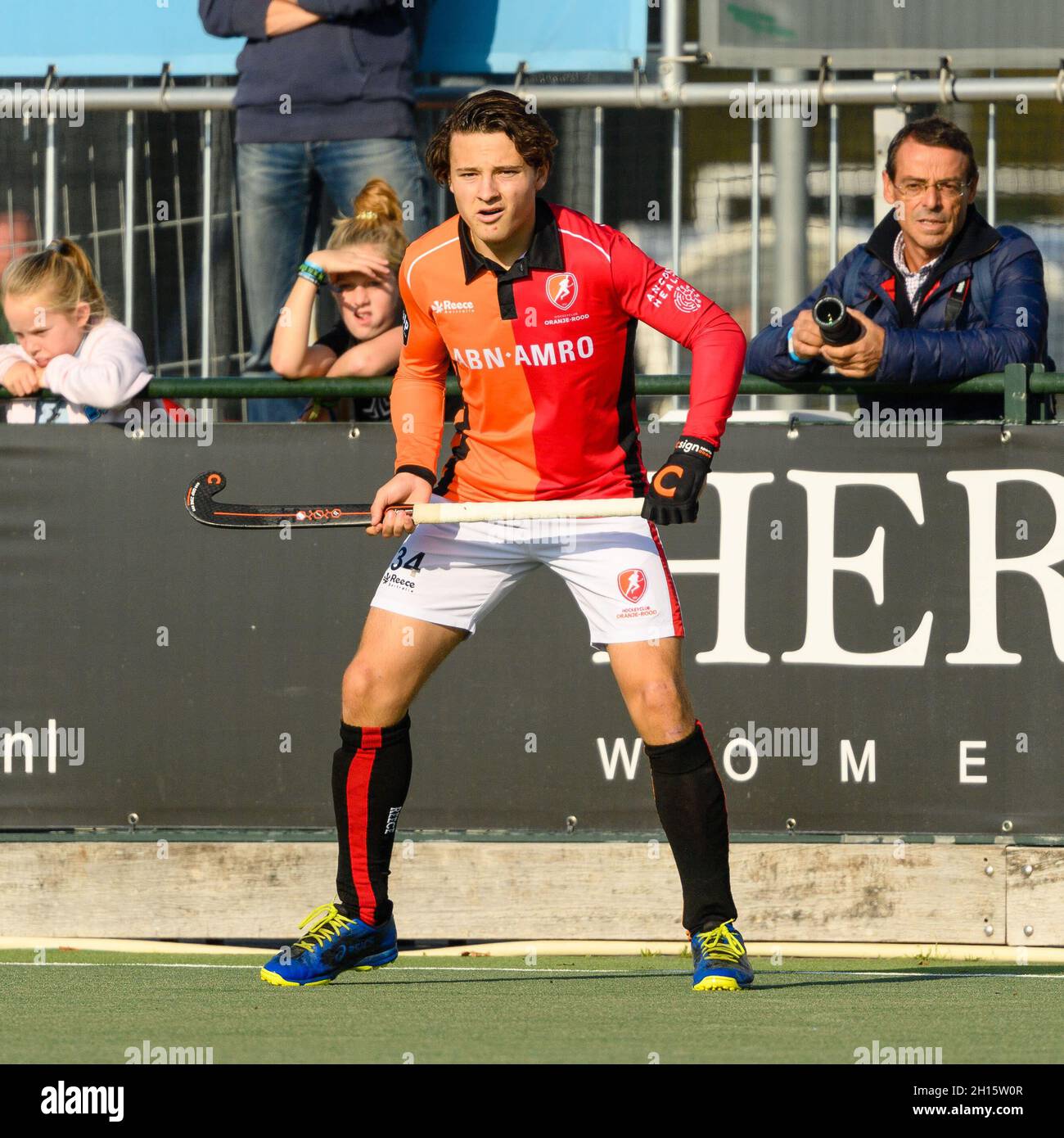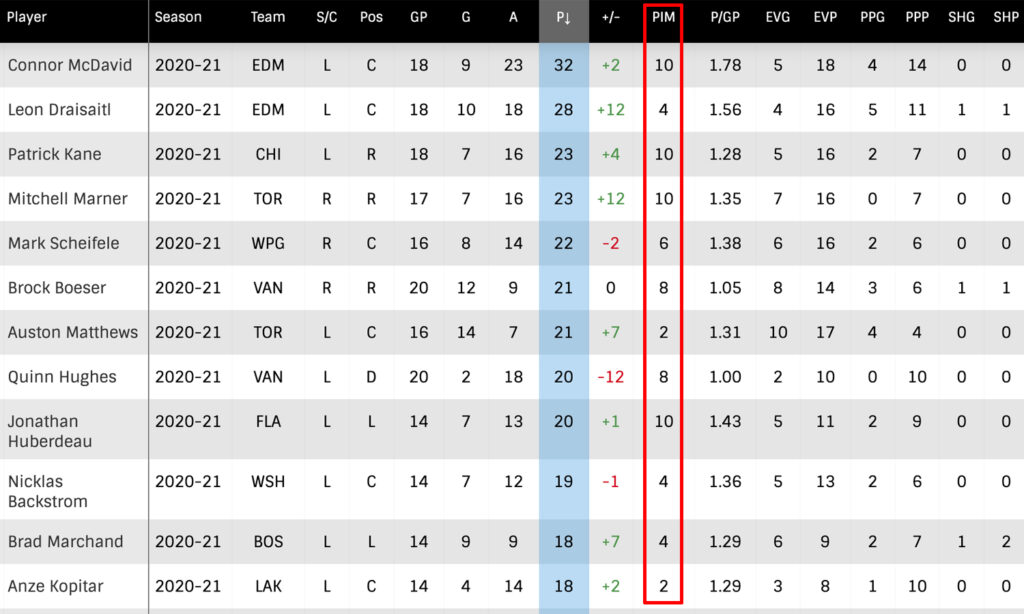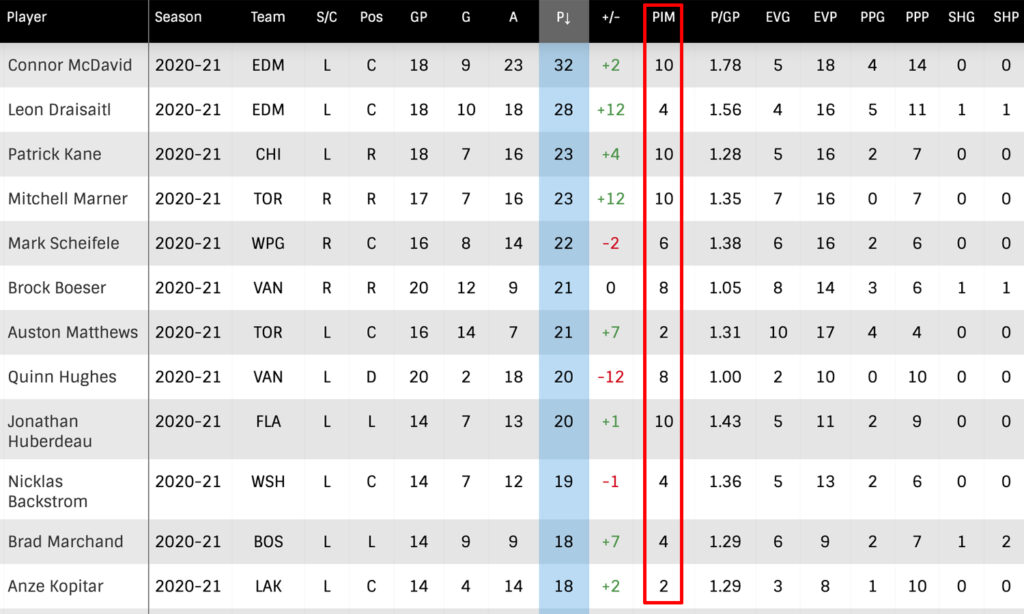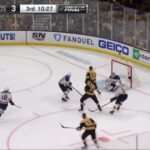PIM in hockey stands for Penalty Infraction Minutes. It measures the total time a player spends in the penalty box.
PIM is a crucial statistic in hockey, reflecting a player’s discipline on the ice. It accumulates every time a player commits a penalty, whether minor, major, or misconduct. Coaches and analysts use PIM to assess a player’s behavior and its impact on the team’s performance.
High PIM can indicate aggressive play but also potential liability for the team. Teams often strategize to minimize PIM to avoid giving opponents power-play opportunities. Understanding PIM helps fans and analysts gauge the discipline and playing style of both individual players and entire teams, adding depth to game analysis.
Types Of Penalties
Understanding penalties in hockey is essential for every fan. Penalties in hockey are given for breaking the rules. They are divided into three main types: minor penalties, major penalties, and misconduct penalties. Each has different consequences for the player and team.
Minor Penalties
Minor penalties are common in hockey. They result in a player spending 2 minutes in the penalty box. Common minor penalties include:
- Tripping: Using a stick or body to trip an opponent.
- Hooking: Using the stick to slow down an opponent.
- Holding: Grabbing an opponent to impede their progress.
Minor penalties can give the opposing team a power play. This means they have more players on the ice.
Major Penalties
Major penalties are more serious. They result in a player spending 5 minutes in the penalty box. Common major penalties

Credit: icebrek.com
Common Infractions
In hockey, PIM stands for Penalty Infraction Minutes. These minutes track the time players spend in the penalty box. Common infractions lead to these penalties. Knowing these infractions is key to understanding the game.
Tripping
Tripping occurs when a player uses their stick, body, or skate to cause an opponent to fall. This infraction is common and results in a minor penalty. The player who trips another will spend two minutes in the penalty box.
- Use of stick or body
- Causes opponent to fall
- Results in a two-minute penalty
High-sticking
High-sticking happens when a player’s stick makes contact with an opponent above shoulder height. This can cause injuries and is penalized to ensure safety.
- Stick contact above shoulder height
- Can cause injuries
- Penalized to ensure safety
A minor high-sticking penalty results in a two-minute penalty. If the infraction causes injury, the player receives a four-minute penalty.
Fighting
Fighting is a serious infraction in hockey. Players who fight receive major penalties.
- Involves physical altercation
- Results in a five-minute penalty
- Can lead to ejection from the game
Fighting penalties aim to maintain the sport’s integrity and player safety.
| Infraction | Penalty Time |
|---|---|
| Tripping | 2 minutes |
| High-Sticking | 2 or 4 minutes |
| Fighting | 5 minutes |
Impact On The Team
Penalties in hockey, often referred to as PIM (Penalty Infraction Minutes), significantly affect team performance. Understanding their impact can help teams strategize better and fans appreciate the game’s nuances.
Power Plays
During a power play, the penalized team has fewer players on the ice. This gives the opposing team a greater chance to score. Teams often use their best players during a power play. They aim to take full advantage of the situation. A high number of PIMs can mean more power plays for the opponent. This can lead to more goals against the penalized team.
Penalty Killing
Penalty killing is the strategy used by the penalized team. They aim to prevent the opponent from scoring during a power play. Effective penalty killing requires strong teamwork and communication. Teams with strong penalty killing units can mitigate the impact of PIMs. Poor penalty killing can lead to more goals against, affecting team morale and performance. Coaches often focus on improving their team’s penalty killing strategies.
| Impact | Details |
|---|---|
| Power Plays | More scoring opportunities for the opposing team. |
| Penalty Killing | Strategies to prevent goals during a power play. |
A team’s ability to manage PIMs is crucial for success. Both power plays and penalty killing play vital roles. Teams need to focus on discipline and strategies to reduce PIMs.

Credit: www.alamy.com
Famous Players With High Pim
In hockey, PIM stands for Penalty Minutes. Players get PIM for breaking rules. Some famous players have many PIM. These players are often called enforcers. Enforcers protect their teammates. They also fight to change the game’s momentum.
Enforcers In Hockey
Enforcers play a special role in hockey. Their main job is to protect star players. They often fight to intimidate the other team. Enforcers are not afraid to get penalties. This makes them leaders in PIM.
| Player | Team | PIM |
|---|---|---|
| Dave “Tiger” Williams | Vancouver Canucks | 3,966 |
| Bob Probert | Detroit Red Wings | 3,300 |
| Rob Ray | Buffalo Sabres | 3,207 |
Record Holders
Some players hold records for PIM. Dave “Tiger” Williams holds the record for most PIM in NHL history. He has 3,966 PIM. Bob Probert is another famous enforcer. He has 3,300 PIM. Rob Ray also ranks high with 3,207 PIM.
- Dave “Tiger” Williams: 3,966 PIM
- Bob Probert: 3,300 PIM
- Rob Ray: 3,207 PIM
Strategies To Avoid Penalties
Hockey is a fast-paced and exciting sport. Players must avoid penalties to succeed. Penalties, or PIM (Penalty in Minutes), can hurt a team’s chances of winning. Here are strategies to help players avoid penalties.
Discipline And Control
Players need to keep their emotions in check. Losing control can lead to penalties. Staying calm helps players make better decisions.
Using proper techniques reduces the risk of penalties. For example, using the stick correctly avoids hooking or tripping calls. Positioning the body well helps avoid interference penalties.
Clear communication on the ice is essential. Teammates should talk to each other to avoid confusion and mistakes.
Coaching Techniques
Coaches play a big role in teaching discipline. They can use drills to help players practice control. For example, drills that focus on stickhandling and positioning can be beneficial.
Coaches can also use video reviews to show players their mistakes. Watching these videos helps players learn what to avoid.
Positive reinforcement encourages good behavior. Coaches should praise players when they avoid penalties and play smart.
| Technique | Benefit |
|---|---|
| Stickhandling Drills | Improve control and reduce stick infractions |
| Positioning Drills | Enhance body positioning to avoid interference |
| Video Reviews | Identify and correct mistakes |
| Positive Reinforcement | Encourage disciplined play |

Credit: www.gaimday.com
Role Of Referees
In hockey, referees play a crucial role in maintaining the flow of the game. They ensure the game is fair and safe for all players. Their decisions can impact the outcome of the match.
Calling Penalties
Referees are responsible for calling penalties during a hockey game. They watch for any rule violations. When they see one, they stop the game and assess the penalty. Common penalties include tripping, high-sticking, and roughing. Referees signal these penalties with hand gestures and verbal calls.
Penalties can be minor or major. Minor penalties lead to two minutes in the penalty box. Major penalties usually last five minutes. Referees also call misconduct penalties, which can be more severe.
Ensuring Fair Play
Referees also ensure fair play throughout the game. They make sure players follow the rules and respect each other. Fair play means no cheating or dangerous behavior. Referees use their whistles to stop play if they see something wrong.
They also monitor face-offs, line changes, and the puck’s movement. This helps keep the game organized. Referees have the authority to review plays using video replay. This ensures the correct decision is made.
In summary, referees are essential for calling penalties and ensuring fair play. Their role helps maintain the integrity of the game. They keep players safe and make sure the game is enjoyable for everyone.
Fan Perspectives
Hockey fans have diverse perspectives on Penalties in Minutes (PIM). Some fans love the physical play, while others debate the need for rule changes. Let’s explore these fan perspectives.
Excitement Of Physical Play
Many fans enjoy the physical aspect of hockey. They cheer when players deliver hard hits. This intensity creates a thrilling atmosphere in the arena. Physical play can change the momentum of the game. Fans often see PIM as a sign of toughness and commitment. They love the energy and passion that come with these moments.
Debates On Rule Changes
Other fans argue for stricter rules on physical play. They worry about player safety and long-term health. These fans believe in reducing PIM to make the game safer. They suggest more penalties for dangerous hits and fights. This debate often divides the hockey community. Both sides have strong opinions on the impact of PIM on the sport.
| Aspect | Pro-Physical Play Fans | Pro-Rule Change Fans |
|---|---|---|
| Enjoyment | Love the intensity and excitement | Prefer skillful and safe play |
| Concerns | None, enjoy the physicality | Player safety and health |
| Suggestions | Keep current rules | Stricter penalties for dangerous play |
Both perspectives add unique elements to the game. Whether cheering for hits or advocating safety, fans shape hockey’s culture.
Frequently Asked Questions
What Does Pim Mean In Hockey?
PIM in hockey stands for Penalty Infraction Minutes. It tracks the total time players spend in the penalty box.
What Does Pim Mean On A Hockey Card?
PIM on a hockey card stands for Penalty Minutes. It tracks the total minutes a player spends in the penalty box.
Why Is Pim Good In Hockey?
PIM in hockey measures a player’s penalty minutes. It indicates physical play and enforcer role. Coaches use it for strategy.
What Is Pims In Hockey Stats?
PIMs in hockey stats stand for Penalty Minutes. They track the time players spend in the penalty box.
Conclusion
Understanding PIM in hockey enhances your appreciation of the game. Penalties impact team dynamics and game outcomes significantly. Knowing PIM rules helps fans and players alike. Keep these insights in mind next time you watch a match. Stay informed and enjoy the thrilling world of hockey!

